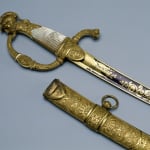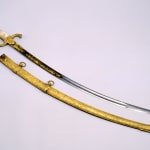Martin-Guillaume Biennais (attributed to) French, 1764-1843
Provenance
Traditionally known to have been given to General Comte Auguste Charles Joseph Flahaut de la Billarderie (1785-1870) by his sweetheart, Hortense de Beauharnais (1783-1837).
Literature
Hugh Honour, "Goldsmiths & Silversmiths", 1971, p. 237, illustrating a comparable sword, now in the Residenz, Munich, made by Biennais for the Emperor Napoleon 1804, who gave it to his stepson Prince Eugène de Beauharnais.
A magnificent and very important Empire gilt bronze sabre attributed to Martin-Guillaume Biennais, the hilt with a Roman centurion head pommel with fantastic animal upon his helmet and the guard with lion head mask, decorated with victorious laurel swags and garlands, one side centred by a pair of spears within a laurel wreath and a centurion torso surrounded by various weapons, the other by a laurel wreath and trophies and Comte Flahaut de la Billarderie's crest, the blade ornamented with floral and foliate swags and various trophies of war and scabbard with similar decoration
Paris, date circa 1810
Length 107 cm.
It has always been accepted that the beautiful Hortense de Beauharnais presented this magnificent sabre to her lover, General Flahaut de la Billarderie. Under Napoleon's command Billarderie was made General of the Brigade, 1813 and of the Division, 1814, and was engaged at Leipzig, Hanau and Waterloo. Later, in 1831 he was appointed minister to Berlin and in 1842 French Ambassador to England. Hortense also came from a distinguished military background. She was the daughter of the French General Vicomte Alexandre de Beauharnais (1760-94) and Joséphine (1763-1814), who after her husband's death at the guillotine married Napoleon Bonaparte, 1796. Hortense's brother, Eugène (1781-1824) accompanied Bonaparte to Italy and Egypt and was made Prince of the Empire and Viceroy of the kingdom of Italy.
At Napoleon's request, in 1802 Hortense married her stepfather's brother, Louis Bonaparte (1778-1846). It was however a deeply unhappy marriage and only endured because Napoleon wished it to appear stable. In 1806 Napoleon created the couple King and Queen of Holland but after a dispute with Napoleon, Louis relinquished the Dutch throne, 1810 and in the same year the Emperor finally allowed Louis and Hortense to separate. Hortense bore Louis three sons of which her third, Charles-Louis Napoleon was later crowned Emperor Napoleon III. In 1811 she and her beloved Comte de Flahaut had their own son, Charles Auguste Louis Joseph (1811-65) who was created duc de Morny in 1862.
Despite her separation from her husband, Hortense remained a loyal adherent to the Bonapartist cause. Her support of Napoleon after his return from exile on Elba, 1815 resulted in her banishment from France following his final defeat. After travelling in Germany and Italy, she bought the Château de Arenenberg in the Swiss canton of Thurgau, where she eventually died in 1837. A number of artists captured her beautifully refined features, including François Gérard, whose portrait of her now hangs at Ash Lawn-Highland Museum, Charlottesville, Virginia.
The Imperial goldsmith, Martin-Guillaume Biennais (1764-1843) who supplied copious amounts of gold and silver to the Emperor, also supplied items to other members of the Imperial family, especially to Queen Hortense. Among pieces for the Emperor were many table services, candelabra, nécessaires de voyage as well as commemorative items such as crowns and commemorative swords and sabres. The sword, which he supplied to Napoleon in 1804 (cited above), was as here, ornamented with many symbolic motifs related to the military successes of Ancient Rome.



